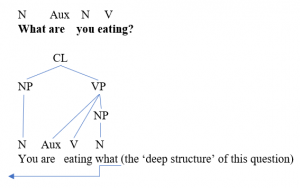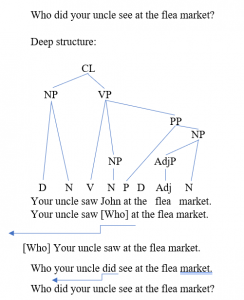10 Chapter 10. Movement and Deletion
Matt Garley
Licensed under a Creative Commons Attribution-NonCommercial-ShareAlike 4.0 International License.
There are some structures that we produce commonly in English that are hard to account for using the model we’ve learned so far. In particular, our model does not deal well with questions, where certain things seem to have moved from the places we expect them.
The most elegant solution to this is to say, well, this isn’t the real structure–instead, our model works on something we’ll call deep structure–a version of certain sentences that we propose exists before things move around and we get to the surface structure, which is the version we say or hear. So we need some rules for movement!
In this chapter, we will deal with three main types of movement:
1) Subject-Aux inversion (swaps Auxiliary in front of the subject)
2) WH-movement (for content questions and certain embedded clauses)
3) Fronting (adjuncts moving to the front of the sentence for stylistic purposes)
Subject-Auxiliary Inversion
Adapted by Matt Garley from work by Paul Junior Prudent and Autumn Matthews.
Subject-Auxiliary Inversion, also called Subject-Aux inversion, or simply SAI, is one of the types of movements in English grammar. In an ordinary sentence, the subject comes before the predicate VP, and inside that predicate, the Aux (if there is any) comes before the V. But there are situations where the Aux jumps out of the VP and comes before the subject of the sentence. Subject-Aux inversion is when the auxiliary verb comes before the subject. That is when the movement happens (Huddleston & Pullum 68).
Yes-no questions
One of the situations where Subject-Aux Inversion happens is in one of the two main types of questions in English, so-called ‘yes-no’ questions, that is, questions for which the answer is expected to be ‘yes’ or ‘no’. In English grammar, the question structure requires the auxiliary verb to precede the subject question (Lobeck et al. 117). For example, in the question “has he seen the movie?” the auxiliary verb “has” comes before the subject “he”. In the question “have you been to Haiti ?” the subject “you” comes after the auxiliary verb “have”.
Subject-aux inversion can work with any auxiliary, including modals, Aux have, Aux do, and Aux be.
The verb “be” also allows the Subject-Aux inversion, even when it is not an auxiliary verb! For example, in the question “are you listening to me?” the auxiliary verb “be” comes before the subject “you”. In the question “is she going to Haiti?” the subject “she” comes after the auxiliary verb “be”. These previous examples show the unique property of the verb “be”, because “be” can act like an Auxiliary verb even if it is a main verb itself (“Linking Verbs”). This also used to be true of have, and we see remnants of this in fixed phrases like “have you no shame?“. However, it would be strange today to sit in a diner and say something like “have you no decaf?”
(1a) Deep Structure: Tasha is playing uno
(1b) Surface Structure: Is Tasha playing uno?
(2a) Deep Structure: The teacher will bring cupcakes to class tomorrow
(2b) Surface Structure: Will the teacher bring cupcakes to class tomorrow?
(3a) Deep Structure: You drink soda
(3b) Surface Structure: Do you drink soda?
In (3a-b) we also see that if no auxiliary (or ‘be’) is present in the deep structure, the dummy auxiliary do is filled in; the formation of yes-no questions is one of the main uses of this auxiliary construction.
Negation
The subject-aux inversion can also happen in a when using negation or to express surprise or shock about a situation or a fact. There are expressions when placed at the beginning of a sentence that require the subject-aux inversion (Brinton & Brinton 233). Expressions that begin with a negative like:
Not only:
(4) Not only was he drafted, he was also the number one pick.
Not once:
(5) Not once did he pass the ball.
At no time:
(6) At no time did I say yes to your demand.
Nor:
(7) I did not think my dad would ever get a new phone, nor did I expect him to
Under no circumstances:
(8) Under no circumstances should you touch the video game
In all of the sentences above the negative expression at the beginning forces the subject-aux inversion.
Emphasis
In this case, the subject-aux inversion happens in a sentence to emphasize something specific. While it could be about something surprising or shocking, the more important thing in this situation is the emphasis on a situation or a fact (Brinton et al. 73). It happens sometimes with words like rarely, never, little… When these words are placed at the beginning of a sentence, they change the structure into a subject-aux inversion. Most of these are somewhat idiomatic, and this is not likely to be productive in making new phrases in English.
Rarely:
(9) Rarely does she wear heels.
Little:
(10) Little did I know.
There are also some other expressions which add the emphasis effect on something specific in a sentence. These expressions are used to make a statement look stronger or to give the sentence more emphasis.
(11) Man, is he stubborn.
This sentence may sound like a question “Is he stubborn?”, but in fact the expression “Man” at the beginning in the sentence puts the emphasis on how “he’s stubborn”. This is not a question, but instead a stronger statement.
WH-Movement
The second kind of movement this chapter will cover occurs with the other major category of questions in English, i.e., content questions. Unlike yes-no questions, this kind of question requests a more detailed answer, and begins with one of the classic ‘question words’–most of which begin with WH. These are who, whose, what, which, where, why, when, and (the odd one out, in terms of spelling) how. We can analyze WH-questions in the same way as yes-no questions, by recourse to deep structure.
The basic mechanism of WH-movement is that regardless of its normal place in the clause, a WH-word which is being questioned must move to the front of the clause.
In cases where the subject is the question word, like “Who did this?”, this is trivial–the subject is already at the front of the sentence, so it makes no difference if the WH-word moves to the front.
In other cases, if the WH-word moves past the subject in moving to the front of the clause, it also triggers SAI if it’s in the main clause.


A special note on ‘whose’ and ‘which’: These do not move by themselves, but act as determiners, bringing an entire noun phrase with them:
(12a) Deep structure: The party will be at whose house
(12b) intermediate form: (WH-movement) Whose house the party will be at
(12c) Surface structure: (WH-movement and SAI) Whose house will the party be at?[1]
Fronting
The last, and simplest, form of movement is called fronting. In general, adjuncts in the VP can be fronted, or moved to the beginning of the sentence before the subject.
Remember that an adjunct is a name for a specific function that dependents of the VP, particularly AdvP, PP, and SC, can have.
Complements are licensed by the verb–remember, they depend on whether the verb can be transitive, linking, complex, but adjuncts are not—they can appear in any sentence.
Adjuncts can optionally be fronted. This is not required, and is usually done for stylistic purposes.
An adverb phrase being fronted:
(13a) John takes a nap at 3:00 usually.
(13b) Usually, John takes a nap at 3:00.
Prepositional Phrase:
(14a) Joan lifted the car with great strength
(14b) With great strength, Joan lifted the car.
Note that unlike adjuncts, complements can’t be normally be fronted, except in a few dialects like New York Yiddish English when focusing or stressing the complement (usually expressing surprise or disbelief) :
(14c) *? The car, Joan lifted?!?!
Fronting can also occur with an adjunct subordinate clause, but not generally a complement subordinate clause:
(15a) James used Febreze because he was out of clean clothes.
(15b) Because he was out of clean clothes, James used Febreze.
References
- Huddleston, Rodney D, and Geoffrey K. Pullum. The Cambridge Grammar of the English Language. Cambridge, UK: Cambridge University Press, 2005.
- Lobeck, Anne, and Kristin Denham. Navigating English Grammar: A Guide to Analyzing Real Language. Hoboken: John Wiley & Sons, Incorporated, 2013.
- Many traditional grammars encourage you not to end a sentence with a preposition. I think my friends would look strangely at me if I said "At whose house will the party be?" In fact, I might not even get invited. ↵
